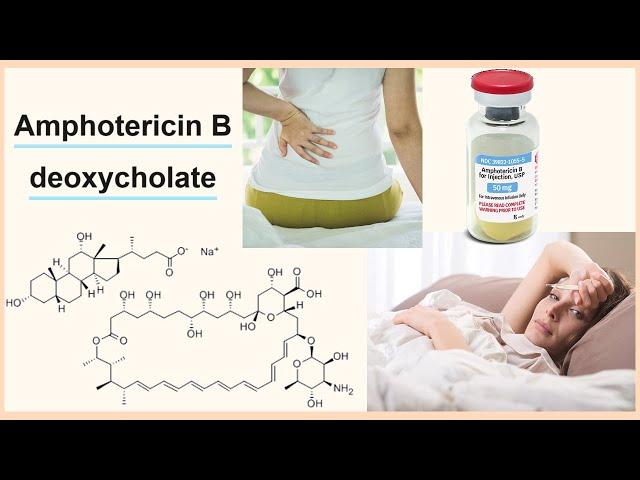
amphotericin B deoxycholate
(ABD, conventional amphotericin B, d-AMB, AmB deoxycholate, AmB-Deox)
The deoxycholate salt of amphotericin B, a polyene antifungal antibiotic produced by Streptomyces nodosus, used for the treatment of invasive fungal infections.
It binds to ergosterol, an essential component of the fungal cell membrane, resulting in depolarization of the cell membrane, alterations in cell membrane permeability, leakage of important intracellular components, and cell rupture.
It may also induce oxidative damage in fungal cells and stimulate the release of histamine from mast cells and basophils.
However, it is associated with adverse drug reactions, including acute kidney injury (AKI) mediated by vasoconstriction and direct tubular toxicity.
Amphotericin B has severe and potentially lethal side effects. The side effects include violent chills and fevers to be nicknamed "shake and bake".
(side effects)
• high fever
• shaking chills
• hypotension
• drowsiness, generalized weakness
• anorexia
• nausea, vomiting
• headache
• dyspnea
• tachypnea
Amphotericin B alone is insoluble in normal saline at a pH of 7. Therefore, several formulations have been devised to improve its intravenous bioavailability.
Also, newer formulations of amphotericin B have aimed to improve the safety. For example, lipid-based formulations are no more effective, although they may be better tolerated by patients.
(Available formulations of amphotericin B)
Intravenously (IV):
• original formulation (conventional amphotericin B, amphotericin B deoxycholate): Uses sodium deoxycholate to improve solubility.
• liposomal amphotericin B: Consists of unilamellar bilayer liposomes with amphotericin B intercalated within the membrane. It improves the tolerability and has less nephrotoxicity and fewer infusion-related reactions.
• lipid complex formulations
- - amphotericin B lipid complex: Amphotericin B with dimyristoylphosphatidylcholine and dimyristoylphosphatidylglycerol.
- - amphotericin B colloidal dispersion: Amphotericin B with sodium cholesteryl sulfate.
By mouth (per os):
• solid lipid nanoparticles: The first generation of lipid-based nanocarriers that are formulated from lipids, which are solid in the body temperature and stabilized by emulsifiers.
• nanosuspensions: Nanosized, heterogeneous aqueous dispersions of insoluble drug particles stabilized by surfactants. Used when a drug molecule has many disadvantages such as inability to form salt, large molecular weight and dose, high log P, and melting point that hinder them in developing suitable formulations.
• cochleates: Lipid-based delivery vehicles consisting of crystalline phospholipid-cation structures that form spiral lipid sheets.
• self-emulsifying drug delivery systems: Work by increasing the solubility and bioavailability for poorly soluble substances. They are composed of oils, surfactants, and occasionally cosolvents.
• polymeric nanoparticles: Shaped like nanocapsules and nanospheres, accommodating improved stability. They have the polymer shell, surround the active compound shell, and exhibits enhanced drug accumulation. They are biocompatible, biodegradable (e.g. chitosan, human serum albumin, bovine serum albumin).
• lipid nanocrystal formulation: A nanocrystal is a material particle having at least one dimension smaller than 100 nanometres and composed of atoms in either a single- or poly-crystalline arrangement.
Cf. imidazole, triazole
The deoxycholate salt of amphotericin B, a polyene antifungal antibiotic produced by Streptomyces nodosus, used for the treatment of invasive fungal infections.
It binds to ergosterol, an essential component of the fungal cell membrane, resulting in depolarization of the cell membrane, alterations in cell membrane permeability, leakage of important intracellular components, and cell rupture.
It may also induce oxidative damage in fungal cells and stimulate the release of histamine from mast cells and basophils.
However, it is associated with adverse drug reactions, including acute kidney injury (AKI) mediated by vasoconstriction and direct tubular toxicity.
Amphotericin B has severe and potentially lethal side effects. The side effects include violent chills and fevers to be nicknamed "shake and bake".
(side effects)
• high fever
• shaking chills
• hypotension
• drowsiness, generalized weakness
• anorexia
• nausea, vomiting
• headache
• dyspnea
• tachypnea
Amphotericin B alone is insoluble in normal saline at a pH of 7. Therefore, several formulations have been devised to improve its intravenous bioavailability.
Also, newer formulations of amphotericin B have aimed to improve the safety. For example, lipid-based formulations are no more effective, although they may be better tolerated by patients.
(Available formulations of amphotericin B)
Intravenously (IV):
• original formulation (conventional amphotericin B, amphotericin B deoxycholate): Uses sodium deoxycholate to improve solubility.
• liposomal amphotericin B: Consists of unilamellar bilayer liposomes with amphotericin B intercalated within the membrane. It improves the tolerability and has less nephrotoxicity and fewer infusion-related reactions.
• lipid complex formulations
- - amphotericin B lipid complex: Amphotericin B with dimyristoylphosphatidylcholine and dimyristoylphosphatidylglycerol.
- - amphotericin B colloidal dispersion: Amphotericin B with sodium cholesteryl sulfate.
By mouth (per os):
• solid lipid nanoparticles: The first generation of lipid-based nanocarriers that are formulated from lipids, which are solid in the body temperature and stabilized by emulsifiers.
• nanosuspensions: Nanosized, heterogeneous aqueous dispersions of insoluble drug particles stabilized by surfactants. Used when a drug molecule has many disadvantages such as inability to form salt, large molecular weight and dose, high log P, and melting point that hinder them in developing suitable formulations.
• cochleates: Lipid-based delivery vehicles consisting of crystalline phospholipid-cation structures that form spiral lipid sheets.
• self-emulsifying drug delivery systems: Work by increasing the solubility and bioavailability for poorly soluble substances. They are composed of oils, surfactants, and occasionally cosolvents.
• polymeric nanoparticles: Shaped like nanocapsules and nanospheres, accommodating improved stability. They have the polymer shell, surround the active compound shell, and exhibits enhanced drug accumulation. They are biocompatible, biodegradable (e.g. chitosan, human serum albumin, bovine serum albumin).
• lipid nanocrystal formulation: A nanocrystal is a material particle having at least one dimension smaller than 100 nanometres and composed of atoms in either a single- or poly-crystalline arrangement.
Cf. imidazole, triazole
Комментарии:
amphotericin B deoxycholate
Air to air
Jorel Diez vs Hex Indy Wrestling! BOTW Lompoc CA 09/30/23
Indy Wrestling! with Randiesel300
흥분하면 커지는 최강 고등학생
쇼츠루


![Best Dubs of March!! [Poppy Playtime and FNaF Comic Dubs] Best Dubs of March!! [Poppy Playtime and FNaF Comic Dubs]](https://ruvideo.cc/img/upload/c2x5dTBFcy1OaUc.jpg)
![Sosa Lean - DEATH NOTE X AJ Leon [ 2024 Official Audio ] Sosa Lean - DEATH NOTE X AJ Leon [ 2024 Official Audio ]](https://ruvideo.cc/img/upload/MHppbFZFU3gzX1Y.jpg)






















